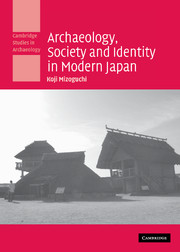Book contents
- Frontmatter
- Contents
- List of figures
- List of tables
- Preface
- 1 Archaeology in the contemporary world
- 2 Modernity and archaeology
- 3 Communication, sociality, and the positionality of archaeology
- 4 Nation-state, circularity and paradox
- 5 Fragmentation, multiculturalism, and beyond
- 6 Conclusion: demands for problematising and explaining one's position all the time
- References
- Index
- CAMBRIDGE STUDIES IN ARCHAEOLOGY
1 - Archaeology in the contemporary world
Published online by Cambridge University Press: 22 September 2009
- Frontmatter
- Contents
- List of figures
- List of tables
- Preface
- 1 Archaeology in the contemporary world
- 2 Modernity and archaeology
- 3 Communication, sociality, and the positionality of archaeology
- 4 Nation-state, circularity and paradox
- 5 Fragmentation, multiculturalism, and beyond
- 6 Conclusion: demands for problematising and explaining one's position all the time
- References
- Index
- CAMBRIDGE STUDIES IN ARCHAEOLOGY
Summary
A scenario of contemporary archaeology
A cluster of pristine-looking wooden structures suddenly appear in front of those who approach a low-lying hill sticking out of the heavily wooded mountain range rising steeply from the rice paddy-covered terrain. The flood plain, stretching to the south until it meets the Sea of Ariake, a large Inland Sea famous for its large tidal movements and unique marine life, is dotted with hamlets, small factories, and occasionally, heaps of industrial waste. What you see is typical contemporary Japanese countryside, where the rural is gradually eroded by the ever-expanding urban and industrial. Against this background, the Yoshinogari Historical Park, which consists of a number of ‘reconstructed’ archaeological features, an on-site museum, and a huge visitor centre with large car parks, looks like a gigantic theme park pretending to be an exotic ancient fortress in a setting most unusual and at the same time most mundane (Figure 1.1). These pristine-looking wooden structures are ‘reconstructed’ Late Yayoi period buildings. The Yayoi period was the first fully fledged agrarian period in Japanese history.
The park is the first of its kind designated by the state, and under the care of, interestingly, the Ministry of Land, Infrastructure and Transport (MLIT: www.mlit.go.jp/english/index.html), not of the Agency of Cultural Affairs (ACA: www.bunka.go.jp/english/2002-index-e.html), which is in charge of scheduling and protecting ‘cultural properties’ including archaeological sites and monuments, both tangible and intangible.
- Type
- Chapter
- Information
- Archaeology, Society and Identity in Modern Japan , pp. 1 - 18Publisher: Cambridge University PressPrint publication year: 2006



